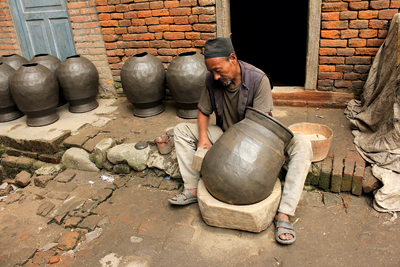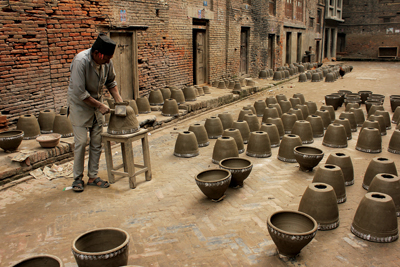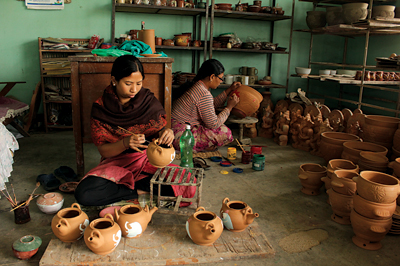Aila, that potent liquor of the Newars, is made using a special ceramic setup crafted just for distilling rice or millet alcohol: several clay containers of various sizes are used in conjunction with a large ceramic vessel with holes punched in the bottom. Without this special holed vessel, the creation of aila would not be possible.

Tepa - a vessel used for making aila (liquor) being produced in Thimi
The streets of Thimi are buzzing with pottery-related activity. Thimi, a charming and slightly weathered town nestled between Kathmandu and Bhaktapur, feels like a beehive, with every resident busy in some part of the production of ceramics. Down one alley, a man dressed in a daura suruwal is clearing freshly fired clay pots from a smoldering kiln. Around another corner, a stern faced woman methodically gives pots a wash of reddish-brown terracotta paint. In an open courtyard, a man wearing a checkered topi pounds the inside of a soft clay water pot with a paddle, fashioning it to the perfect width.

Ceramic products can be for both household and religious use.
Thimi and its Prajapatis
Thimi is regarded as the center of ceramic making in Nepal. When finished, the pots, bowls, containers and cups made in Thimi will be sent by truck all over the country, to the urban cores of Kathmandu and Bhaktapur and to villages from east to west. Just as bees in a beehive spend their days doing their part to produce honey, so too the artisans and residents of Thimi spend their days producing clay goods that are both culturally and religiously important to Nepalis. Ask almost anyone their surname in Thimi and the answer will likely be “Prajapati.” The name “Prajapati” comes from the Sanskrit word “producer” and is the traditional Nepali caste of potters. By local estimates, 95% of people residing in Old Thimi have the last name “Prajapati.”
Terracotta ceramics have a long history in Nepali culture and religion that is still alive and well today. Hari Prajapati, one of the founders of Nepal Ceramics Cooperative Society, has been actively involved in Nepal’s ceramic industry for decades. As he strolls through Thimi’s stone-paved lanes and narrow alleys, he greets everyone he meets by name, watching as they clear kilns, spin pottery, pound clay and load finished pots into transport trucks. From his work as a potter, as well as a community activist, he understands the importance of terracotta pottery in the everyday life of many Nepalis.
Many uses, and healthy too
Prajapati explains that large ceramic water pots can be found in almost every village in Nepal, which are used to collect, store and transport water. Clay goods are also essential to many Hindu and Buddhist religious ceremonies. “When you do a big puja, you need a clay pot. When someone dies, you need clay pots,” he says about rituals that take place on the stone ghats, or platforms, that line Nepal’s sacred rivers. “Clay pots are very holy items.”
Although handmade ceramic pots have been widely used for centuries, Prajapati says that many villagers and Nepali urbanites have started using aluminum and plastic containers instead because they are often cheaper and easier to transport. Unfortunately, there are negative health effects that stem from storing water in plastic and certain metal containers. “It’s like a slow poison,” Prajapati explains. “It slowly wrecks your health.”
Water that is stored for long periods of time in some plastics leech harmful chemicals from the container that can adversely affect health. When people began to realize that more harm than good was done using these containers, business began to once again pick up for potters making water pots. There are an estimated 10,000 to 12,000 people spread throughout Nepal who are potters by family heritage, but only a fraction these people continue to work in the ceramics industry. Members of the younger generation, the children of life-long potters, often chose to go into other lines of work like transportation or factory tailoring because of more lucrative financial opportunities. Most potters in Thimi are visibly ageing and hopefully, they will not be among the last generation to propagate clay traditions.

Terracotta ceramics have a long history in Nepali culture and religion
Great Diversity Pottery making is a family business in Thimi
Despite the changes in the industry, a walk through Nepal’s towns reveals a spectacular diversity of ceramic goods. Clay water pots are ubiquitous in villages, even with the spread of plastic, because of their utilitarian value and durability. During pujas and ritual ceremonies, small ceramic cups are used to hold candles and ghee (butter) lamps. In many tea shops, ceramic mugs are used to serve piping hot chiya. During a traditional Newari meal, samay baji, distilled rice wine known as aila is sipped from tiny ceramic dishes. That aila was even made using a special ceramic set-up crafted just for distilling rice or millet alcohol: several clay containers of various sizes are used in conjunction with a large ceramic vessel with holes punched in the bottom. Without this special holed vessel, the creation of potent aila would not be possible.
On a recent October afternoon, Prajapati strolled through the streets of Thimi explaining the history of the town and pointing out community members who were busy at work on different links in the chain of pottery production. According to Prajapati, Thimi was once like a small country within itself, some 400 years ago. A major earthquake caused all the buildings in the region to collapse, which spurred the king of Thimi to move to Bhaktapur. Thimi, although small, has remained the country’s central enclave of potters. Perhaps that is because a community has long been established here, but the area around Thimi is also a hotbed for high-quality clay that is of exceptional plasticity.

After the rice is harvested in October, the upper layers of the fields yield the raw material that is used by potters, but the job of collecting clay locally is difficult and labor intensive. Unfortunately for local potters, the government has planned a housing development on the plot of land that yields much of the clay used in Thimi. When this area is covered with houses, potters will have to bring in more clay from Patan and Bhaktapur or import processed clay from abroad. “Collecting clay is very difficult work,” explains Prajapati. “But the pottery business is in high demand, so it is worth it.”
When Prajapati speaks of “traditional” Nepali pottery, he means terracotta, which can be identified by its deep red and brown tones. A number of potters and artisans are now engaged in non-traditional pottery, which can be classified as ceramics that are washed or painted with colored glaze. Glazed pottery was introduced to Nepal 25 years ago and the practice is now thriving in Thimi, thanks to the smooth transition from traditional to modern by potters themselves, along with assistance from the Nepal Ceramics Cooperative Society (NCCS).
It is thanks to the concerted efforts of Prajapati and others that modern technology has been introduced thus enabling potters to make glazed ceramics. A special kiln, along with chemicals and colored glazes are needed, none of which were available in Nepal before the 1980s. NCCS, which currently has 39 members, was founded in 1995 to address this issue and to support both modern and traditional potters. After its foundation, the group imported chemicals and glazes from India, processed them in Nepal and sold them to glaze potters, allowing this facet of the business to blossom. Now, there are dozens of glaze potters in Thimi who are doing bustling business both locally and in exports. Their wares are painted in both subdued and brilliant colors, some plain and some covered with detailed designs.
On the outskirts of Thimi behind a bustling workshop, Laxmi Krishna Prajapati is loading painted ceramics into a kiln. He says his glazed pottery is sold mostly locally in Nepal, especially to big Kathmandu hotels that are looking for specialty products. Laxmi Krishna is a member of the NCCS and is an example of someone who has benefitted from the introduction of glazes to Nepal’s pottery industry. In the front room of the workshop women skillfully paint intricate glaze designs on the sides of dried bowls, plants and cups.
“I’m proud that we do everything here,” says Laxmi Krishna, as his amicable teenage daughter happily watches her father work. “I’ll keep doing this work with ceramics. I’ve been doing it my whole life.”











